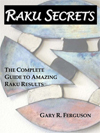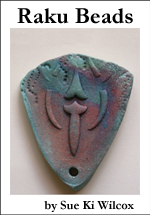|
|
|
April 2006 Issue
#38 In This Issue ~-~-~-~-~-~-~-~-~-~-~-~-~-~-~-~-~-~-~-~-~-~-~-~-~-~-~-~-~-~ * It is all in the Bisque John J. had a really bad day... I have both of your Raku books ( http://www.rakusecrets.com and http://www.rakuglazes.com) and have found them very useful. I have a teaching studio and we have done a few Raku firings with fairly good success. Especially when considering beginner potters’ pots!
This past Saturday we Raku fired again with horrible results - lost 80% of the pieces. Pots were cracked when removed from the kiln and most fell apart after reduction. I used the same clay from the same batch as before which was Standard’s 239.
The only variable I can see is that I bisque fired at a “fast bisque” to ^05 rather than a slow bisque to ^05 (using a controller) as I always do.
The other issue is that we had very little copper coloring. We used your Red Bronze as well as Roberts Copper and Red Luster. We had lots & lots of green but virtually NO copper or reds; and minimal metallic flashing of any color. Raku firing was done to 1800F in an Olympic Raku kiln.
Did I fire too high and/or too fast in the bisque firing? Did I fire too high and/or too fast in the glaze firing? Did I not reduce long enough to a cool enough temperature?
Obviously my students were very disappointed as it was for them. Not to mention I lost 9 out of 10 pieces. My only successful piece was a lidded form 12” high x 10” wide with clear inside and horsehair with ferric chloride outside. It was a very nice piece but 1 out of 10 is not cool!
Any advice? ~~-~-~-~-~-~-~-~-~-~-~-~-~-~-~-~-~-~-~-~-~-~-~-~-~-~-~-~-~- Raku 2nd Edition – Tim Andrews This new edition has been completely re-written and updated with over 200 all new, full-color photos of beautiful Raku pottery http://tinyurl.com/bt7fk ~~-~-~-~-~-~-~-~-~-~-~-~-~-~-~-~-~-~-~-~-~-~-~-~-~-~-~-~-~- I hate days like that! And I really hate it when that happens with new Raku potters. It can be very discouraging. Well I do have some thoughts. I’m glad you mentioned the difference in the bisque process because I had a “great” Raku experience once with a bad bisque firing. The bisque firing got cancelled a little early and did not reach my normal bisque temperature of cone 06. I’m not sure what it really did reach but it was safe to say it was well under cone 06. Well when I went to fire those pieces, they either exploded in the kiln or cracked during the reduction process. I attribute this to a couple of things. The piece would probably absorb more glaze/water than normal, which could affect the firing. Also there may be more “gas/water” that needed to be released during the bisque process that was occurring during the Raku firing which again can cause cracking/breaking problems depending on your Raku firing speed. So your bisque firing may definitely be the culprit. Breakage could also be cause by Raku firing too fast as well, but I’m not sure what your normal firing process is. As far as the lack of Copper or Red colors goes, this is normally due to not enough reduction, either in the kiln or post-firing. Normally for reds you need heavy reduction in the kiln and for coppers you need heavy post-firing reduction. Hang in there. Better days are coming! . |
||
|
Books
Learn Dozens of Hints, Tips and Techniques in the free monthly newsletter Just
Raku Privacy Policy - Your email address or other personal information will only be used for this newsletter. It will never be given, rented, or sold to any other party for any other purposed. |
||
|
Gary R. Ferguson - Raku Artist (c) Copyright 2006, Gary R. Ferguson |
||



